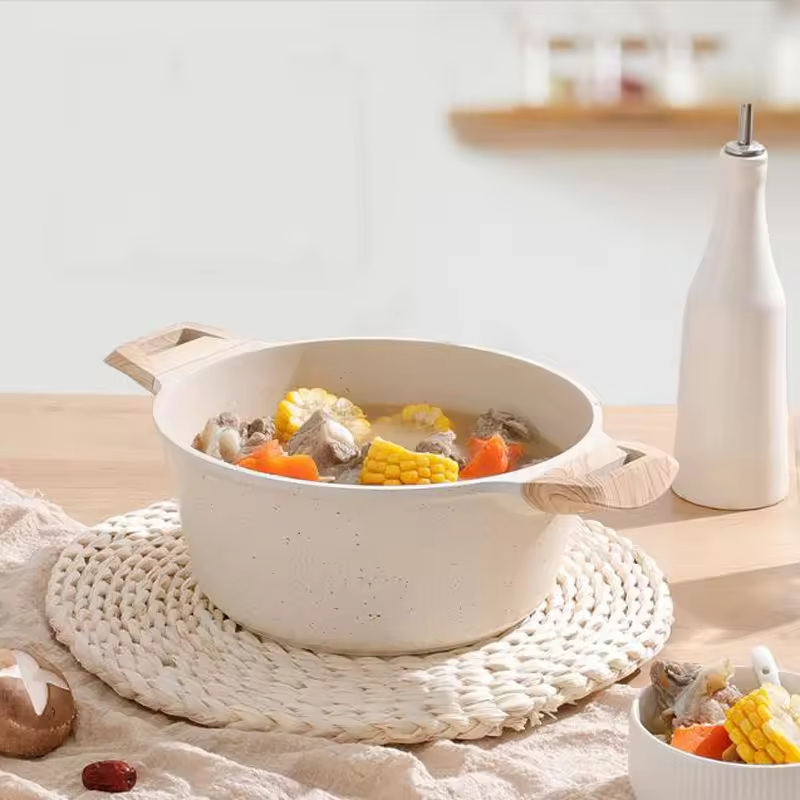How Does a Hard-Anodized Stock Pot Improve Heat Distribution?
May 15, 2025
When it comes to cooking, particularly for tasks like simmering and boiling, a stock pot is indispensable. Among the various types of stock pots available, the Hard-Anodized Stock Pot stands out for its outstanding heat distribution capabilities.
Understanding Heat Distribution in Cookware
Before diving into the specifics of Hard-Anodized Stock Pots, it's essential to grasp the concept of heat distribution. Even heat distribution is crucial for cooking, as it ensures that food cooks uniformly, without hot spots that can cause burning or uneven cooking. This is where the Hard-Anodized Stock Pot excels.
The outstandingity of Hard-Anodized Stock Pot
A Hard-Anodized Stock Pot is crafted from aluminum that has been treated with an anodizing process to create a hard, durable, and non-reactive surface. This process not only enhances the pot's durability but also improves its heat distribution properties. The aluminum core of a Hard-Anodized Stock Pot conducts heat quickly and evenly, which is then distributed across the entire surface area of the pot. This is in contrast to some other materials, like cast iron, which may take longer to heat up and can develop hot spots.
Comparing with Blue Diamond Stock Pot
The Blue Diamond Stock Pot, known for its diamond-reinforced ceramic coating, is another popular choice. While it offers non-stick properties and is highly durable, it may not match the heat distribution capabilities of a Hard-Anodized Stock Pot. The diamond particles in the Blue Diamond Stock Pot provide scratch resistance, but the ceramic coating can sometimes cause heat spots if not heated evenly. This is where the Hard-Anodized Stock Pot's uniform heat distribution comes into play, offering a more consistent cooking experience.
Ceramic Coated Stock Pot vs. Hard-Anodized Stock Pot
The Ceramic Coated Stock Pot is a great option for those who value non-stick surfaces and easy cleanup. However, when it comes to heat distribution, the Hard-Anodized Stock Pot often outperforms. The ceramic coating can be more sensitive to temperature fluctuations and may not conduct heat as evenly as the hard-anodized aluminum. This can result in areas of the pot that are hotter than others, potentially cause overcooking or burning of certain parts of the food. In contrast, the Hard-Anodized Stock Pot's even heat distribution ensures that your food cooks uniformly, regardless of where it's placed in the pot.

Benefits of Hard-Anodized Stock Pot for Heat Distribution
1. Even Cooking: With a Hard-Anodized Stock Pot, you can be confident that your food will cook evenly, avoiding the common issues of hot spots and uneven cooking that can occur with other types of cookware.
2. Efficiency: The quick heat-up time of a Hard-Anodized Stock Pot means you can start cooking sooner and potentially finish faster, making it more energy-efficient.
3. Longevity: The hard-anodized surface is resistant to scratches and corrosion, ensuring that your stock pot will last for many meals to come.
4. Versatility: Hard-Anodized Stock Pots are suitable for a wide range of cooking methods, from boiling to simmering, and can be used on various heat sources, including induction.
5. Safety: The non-reactive nature of the hard-anodized surface means that no harmful substances can leach into your food, making it a safe choice for cooking.
A Hard-Anodized Stock Pot is an outstanding choice for those looking to improve heat distribution in their kitchen. Whether you're preparing a large pot of soup, boiling pasta, or making a hearty stew, the even heat distribution of a Hard-Anodized Stock Pot ensures that your food cooks consistently and safely. While both Blue Diamond Stock Pot and Ceramic Coated Stock Pot have their merits, it's the Hard-Anodized Stock Pot that truly stands out for its heat distribution capabilities, making it a valuable addition to any kitchen.
 English
English русский
русский Français
Français Español
Español Português
Português عربى
عربى














